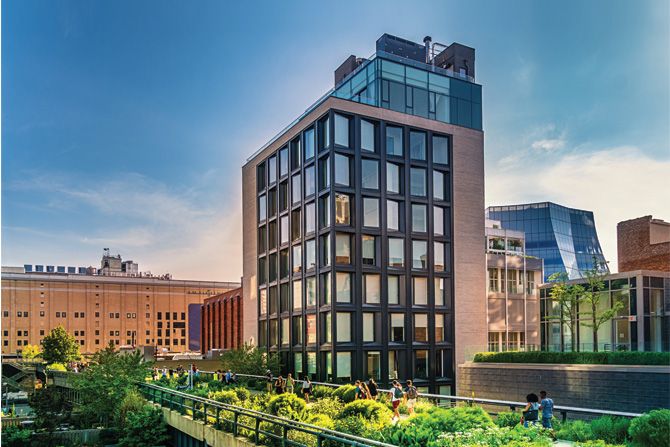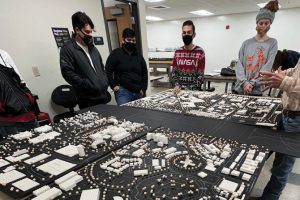“Sustainability is unappealing if it’s always portrayed as something negative, a form of moral self-denial. An ethical dilemma, a moral sacrifice, a political dilemma or a philanthropic donation. We are changing the angle and saying that sustainable cities can be a way of improving our quality of life.” – Bjarke Ingels, Danish Architect
The world population continues to increase. The latest estimates from Population Connection claim we will add an additional two billion people to the planet by 2050 and another billion by 2100. Besides feeding and clothing this daunting number of humans comes the question of how to shelter them. Surely at some juncture, we may decide that instead of finding usable land upon which to build, we will realize that repurposing as much as possible – rather than finding something new – is the only answer to that growing question.
Aging buildings can be a waste of land and resources if we don’t use them. They become a shadow of our past rather than a viable historical story-telling part of it. We should use what we already have in a way that will inspire our future. How we use those older, less-impressive, dilapidated shells can make a difference to those who will come after we are gone.
If we phase out the “knock it down/build it again” mentality and decide to repurpose what already exists, we may find ourselves ahead of the game. But while creating the right buildings for all phases of existence – residential, commercial and industrial – may sound easy, we need to repurpose those buildings containing what is often called “good bones,” or simply, heart.
Repurposing old buildings – sometimes called “adaptive reuse” or “sustainable design” – matters. It is through adaptive reuse and sustainable design that opportunities abound. When buildings are repurposed, job opportunities open to surrounding communities and allow for economic growth. Human resources are in demand while the need for more materials falls. This lowers investment costs and allows more focus on revitalizing, restoring and recycling the area. The global community sees this as a stepping stone in shaping individual communities, paving the path to improving the human relationship with the environment. Other viable parts of adaptive reuse projects are the federal tax credits that may help finance them. For example, if a building is over 50 years old and on the National Register of Historic Places, up to one-fifth of its rehabilitation costs could possibly be expensed and, therefore, be tax-deductible.
Surprisingly, sustainable design is relatively new. But with our population increasing and the ever-decreasing areas of land upon which to build, adaptive reuse is one answer architects have begun to embrace. Protecting historic buildings became more commonplace in North America in the 1960s, but it was a slow trend. However, people began to understand the benefits of reusing old buildings, and the movement increased. For architects, adaptive reuse saves both materials and the community; it decreases urban sprawl and increases sustainability and has even become a political talking point over the past several years.
And it’s not just the architecture industry that has embraced adaptive reuse and sustainable design. It’s becoming more popular in construction circles, too. Sometimes retrofitting an existing building can be more cost-effective than building something new. And the savings in other areas is arresting as well, as some of the main objectives of sustainable design are to reduce the depletion of critical resources such as water, energy, raw materials, and land.
There are six tokens of sustainable design: optimizing size potential, minimizing non-renewables, use of environmentally preferable products, protecting and conserving natural resources, enhancing environmental quality, and optimizing maintenance practices. Through these tokens, architects and construction engineers can secure the safety, health and comfort of a building’s occupants. The environmental impact may be lessened, and neighborhood integrity and security can be preserved.
“Adaptive re-use architecture takes important, structural pieces of the past and makes it relevant to both the present and, thus, the future. By utilizing this to the maximum, we save our history from demolition and our future generations from having to start over with everything,” says Avery Zamora, a business writer from Draft Beyond and Research Papers UK.
Since the past is such a viable and vibrant part of our present, it only makes sense to repurpose what it once was. Adaptive reuse can help to maintain our heritage and is a form of historic preservation. Restoring significant sites that would otherwise be left to ruin helps us make way for a greater cultural revitalization.
When sustainable design is used in cities, urban sprawl ceases or, at the very least, slows down. This will slow air pollution, dangerous traffic, costs, etc., and leave a city revitalized and refreshed. The city then becomes a beacon for the community.
Let’s face it: the one thing no one can make more of is land upon which to build something new. So we should be taking what is already there and repurpose, redesign and reuse it. This is exactly what has occurred in several projects in the U.S. For example, the highly popular internet search engine company, Google, houses its headquarters in what was once an old airplane hangar owned by the world’s first billionaire, Howard R. Hughes. What once held the largest “flying boat” – an airplane called the Spruce Goose (a term Hughes despised) – now houses the entire Los Angeles Google campus. When the huge plane was moved to Oregon, the place sat empty, abandoned, for years. But Google, using an adaptive approach, preserved much of the wooden exterior and retrofitted the inside with steel and concrete to make it more sturdy. More stories were added, creating a cascading effect upon which people can gaze upon the incredible structure.
One of the most well-known green spaces in the world is New York City’s High Line Park. It features hundreds of plants and greenery, but once was the site of an elevated railway line used to move goods along the west side of the city. Once trucks began to move products, the line fell out of favor and became derelict from disuse. But in the early 2000s, the City decided to repurpose the space. Lots of ideas were tossed about, but since the residents wanted to maintain the shell of the original railway, landscaping, art and seating areas were installed. Who knows? It could have become more housing through adaptive reuse, but green spaces are becoming just as necessary as housing, so one could argue it was a well-configured idea.
And then there is the Emporium in San Francisco. It’s now a large retro arcade bar with pinball machines and arcade games. A few years ago, it was an abandoned building, once the home of Harding Theater that originally opened in 1926. After being closed for several years and sitting empty for decades, the city decided it was a landmark and transformed it. The exterior remained, and the interior was completely refurbished to create the classic game haven it has become.
Just because some type of architecture was once housing, apartments, a rail line, a theatre or a subway station doesn’t mean it cannot be reused. How about turning an unused power plant into something fresh and fun, like multi-family housing with green spaces and running trails, fish ponds and bike ramps? Or repurposing an outdated shopping mall into partial student housing for a nearby university with an attached library?
It’s important to remember that adaptive reuse is not simply a sentimental drive to rescue buildings. It is a valuable method to conserve materials on both a community and global level. It challenges the societal culture of fast consumerism, teaching people how to truly appreciate what is here now. As former Prime Minister of Norway Gro Harlem Brundtland so eloquently stated: “Sustainable development is that which meets the needs of the present without compromising the ability of future generations to meet their own needs.”
The only thing that could stop architects – commercial, residential, landscape, sustainable, urban design, industrial, conservation, etc. – is imagination. Thankfully, however, imagination is never lacking with architects. And that is why the old can become new, the unused can blossom and the forgotten can rise once again.








